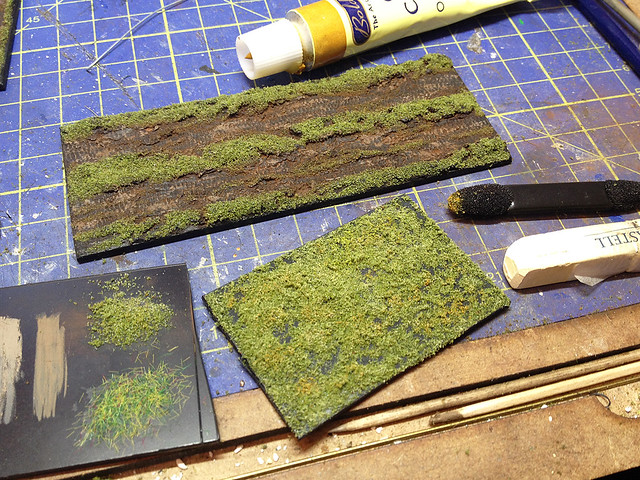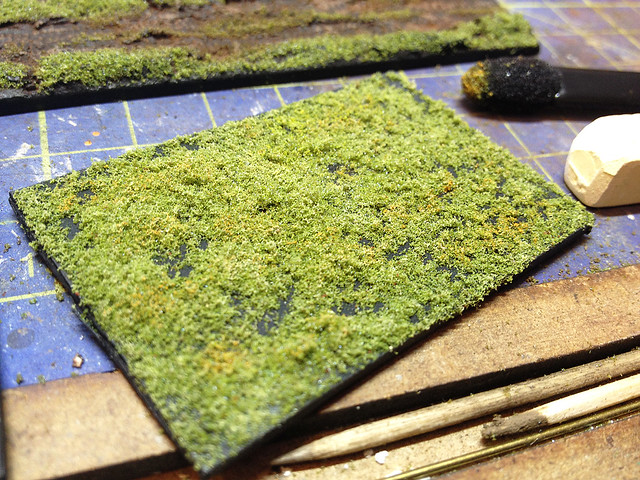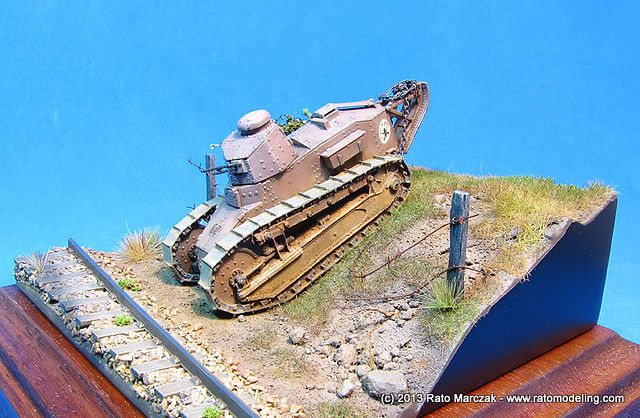As a beginner it is sometimes a little over-whelming the amount of things you seem to need to become adept at just to get a model finished. You need to be a bit of a sculptor, a bit of a painter, a bit of a make-up artist and a host of other things. This is evident when it comes to making bases or dioramas for your models.
Take grass. So far I have been the 'sprinkle it on' newbie, not paying that much attention to it and relying on the quality of the stuff I get 'out of the bag'. But in my latest project I wanted to push my grass-making skills just a little further. I wanted to make realistic 'multi-tonal' grass.
Now, so far I have used Citadels 'static grass', this is both multi-tonal (contains a range of coloured particles to add depth) and is a strand based scale grass medium...
In the above photo you can see my 'test palette' where I have daubed some of the mediums I want to use in my model bases before I started so I can visualise the kind of effects they will produce. The Citadel static grass is the medium on the bottom right. As you can see, unlike traditional model railway 'flocking' it is tiny strands of fake grass and so, in theory and when used properly, mimics the nature of real strands of grass.
I have had two problems with this sort of 'strand' medium. First of all I am dubious about it's scale - at 1/72 or lower it looks a little too big and fake (I think). For although wild grass can get long generally speaking it is shorter than this, particularly in farmed land where it might be grazed on by cattle. The other problem I have with it is that when it's just sprinkled on - as it is above - it just lays flat, like it has been cut, and again looks a bit silly.
So, I have reverted to the traditional - and very cheap - railway modeller flocking. The small granular and mossy medium does not have the realistic advantage of strand-based fake grass, but it's smaller size does - I think - compliment braille scale projects better.
The main problem with the type I bought is that it is one flat uniform colour which is not so realistic. Natural grass is a range of tones and shades, it can be dry grass in which case it can have a brown tone to it or it might be new grass in which case it might be a more vibrant green.
To add this effect to my granular flocking I decided to add some additional colouration by using some oil paints, artists chalks and washes...
The effect is quite subtle - hopefully - but adds some depth and shade to the grass. I daubed on some ochre and brown oil paint using an eye-shadow applicator (a small sponge) and I added highlights using a very light beige artists chalk. Either medium can then be blended into the grass using a fingertip or another eye-shadow applicator. The end result is a multi-tonal mossy effect...
As I said, I've gone for a very subtle variation in tone, but you can go in heavier if you wish adding more contrast and shadow tones. I could have - for example - added a dark brown wash to increase the three-dimensional look, but I decided that the dark muddy browns of my actual finished bases would suffice for the underlying shadow tones.
Postscript - using static grass properly
Looking about at other far more advanced scale modellers static grass (the strand type) seems to be a medium worth persevering with but only if it's applied properly! By 'properly' I mean getting the tiny strands of fake grass to stand up as real blades of grass do.
So I did some research and again railway modellers seem to have the solution to this, and the clue is in the name - 'static' grass!
Take a look at the following video about a device called the 'GrassMaster' made by a company called Noch...
I intend to revisit my grass-making techniques later, but in the mean time and in particular my current Finnish Army project I shall stick to my granular flock technique (particularly when the Noch Grassmaster is a whopping £129). But it's worth knowing how to apply static grass properly for future projects, and if I win the lottery!
In case you are still unconvinced about the use of static grass in Braille Scale (and I concede that if you are making a wargaming base static grass might be over-kill) just take a look at what a difference static grass done properly can make to a scene...
(The above scene is by Rato Marczak © 2013 - and more shots of this exquisite display model can be seen here: RPM Renault FT-17 in 1/72)




No comments:
Post a Comment